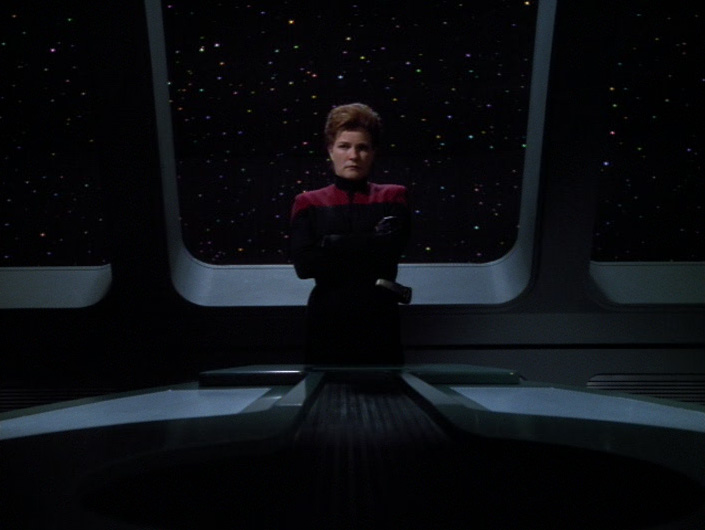
I love the trope of alternate universes. It’s a very comforting concept: another universe, another version of reality, another me living another life. Somewhere I majored in Marine Biology. Somewhere Hillary Clinton is President. Somewhere everything is different, but I’m still me. That’s the conceit, and that’s the key. Let’s say I choose to write a story about a cafe called Enterprise, where Kirk, Spock, McCoy, Uhura and the rest are teenage baristas. How do I make these characters familiar to the audience without a starship, or a rank, or a mission? In a world where Vulcans and transporters don’t even exist? What makes Spock Spock? What makes me me?
There are three episodes of Star Trek: Voyager that play with this trope. These episodes do not depict canonical alternate universes as in “Mirror, Mirror” or “Parallels,” or an alternate timeline as in “Year of Hell” or the most recent films, but fictional versions of Voyager’s reality. And they’re fascinating.
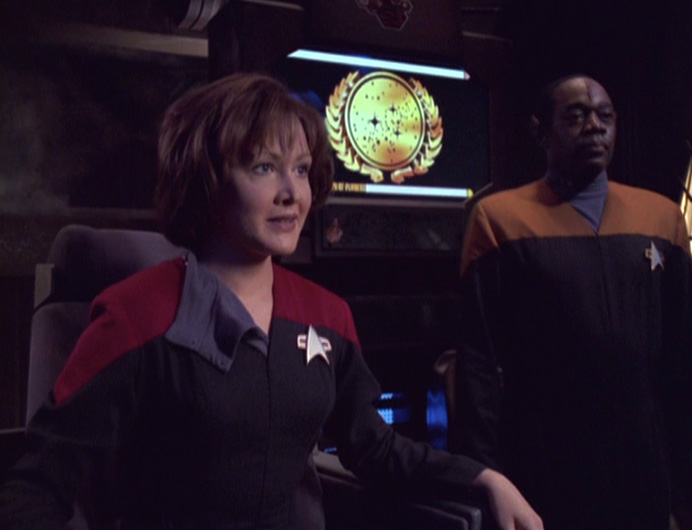
Dala plays Janeway in “Live Fast and Prosper”
“Live Fast and Prosper” and “Muse” aired back to back in Voyager’s sixth season and both contain a guest character recreating the crew of Voyager to serve their own interests. In the first, a con-woman, Dala, downloads some of the ship’s records and uses the information to portray “Captain Janeway” and sell memberships in the United Federation of Planets. She has her own faux Chakotay, Tuvok, and Delta Flyer. In the second episode, a playwright, Kelis, finds the crashed Flyer and uses B’Elanna’s last log entry as the basis for his latest play. When B’Elanna wakes he trades her parts to repair the Flyer for more stories about Voyager.
Both episodes explore the power and the danger of storytelling. Dala tricks individuals, ships, entire societies with her lies. Kelis attempts to stop a war with his play. Neelix and Janeway trap Dala with a story. B’Elanna argues that Kelis’s story has to be more than a collection of hopes, dreams, and kisses to make his point. The guests and the crew use the “alternate universe” the Delta Quadrant natives have created to their advantage, but by interacting with it, they become invested. In both episodes “Tuvok” is portrayed as a difficult but rewarding role that inspires self-reflection. Neelix uses his real Voyager origin story to lull Dala into a sense of false security. B’Elanna refuses to be rescued until the play is over, on her terms.
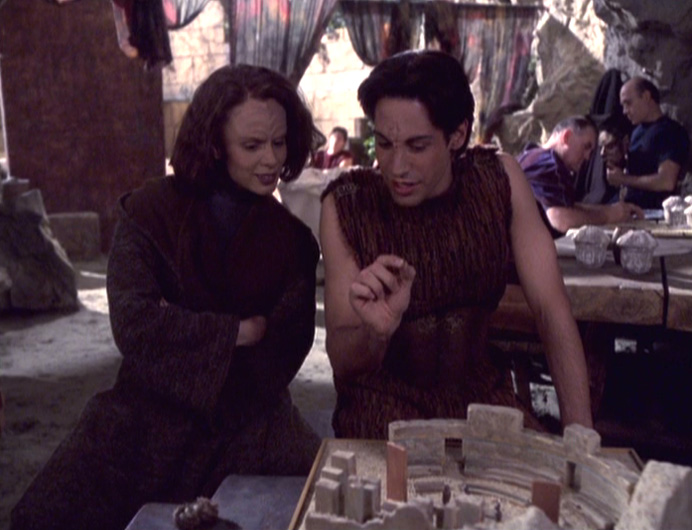
B’Elanna and Kellis in “Muse”
In the end, Voyager moves on and we don’t learn what happens next or what the lasting effects of Voyager’s story are. Another alternate universe episode deals specifically with those questions.
“Living Witness” is an excellent episode — I consider it one of the best in the series — in which a back-up version of the Emergency Medical Hologram is activated in a Kyrian museum seven hundred years in Voyager’s future. He discovers the Kyrians blame “the warship Voyager” and her crew, in collusion with Kyrian enemy the Vaskans, for a bioweapon attack that killed millions of their people. The Doctor is horrified that his, now long dead, friends are being portrayed as monsters, the aggressors are cast as victims, and he is personally being held responsible for genocide.
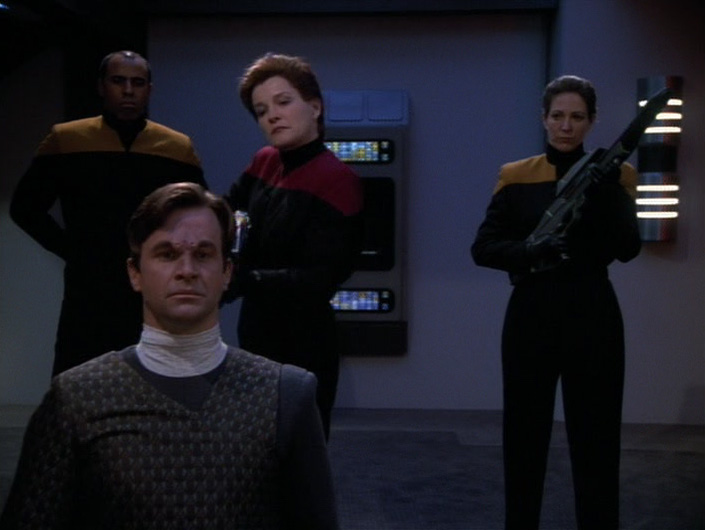
Alternate Janeway prepares for an execution.
The episode is brilliant for three reasons. First, it allows for hilariously incorrect depictions of the crew. Tuvok is a sadist, Chakotay is a torturer, Janeway assassinates people in order to get her ship home, and most damningly, has a super short haircut. But while these versions are invalid, they are still recognizable. Their key traits are twisted and exaggerated, but they remain key traits. This in wildly entertaining. It is also revealing: look how easily our best traits may become our worst.
Second, it portrays the dangers of conflating historic record with fact or truth. Quarren, the Kyrian scholar who maintains the museum, extrapolated his facts from what parts of the story he had access to. He admits to filling in gaps with theory, but he believes in it, and the Kyrians in power treat it as reliable and accurate. They are set to put The Doctor on trial for murder based on this history.
Meanwhile, the Vaskans start a rebellion because The Doctor’s version of events hews closer to their own understanding of history, which has been suppressed by the Kyrians. There are two important lessons here, both of which are relevant to current events in the real world. People in power are more concerned with retaining power than addressing or even considering inaccuracy. And blaming a villainous third party results in a status quo of systemic racism. The Doctor wakes up seven hundred years later, and nothing has changed between the Kyrians and Vaskans.
Third, The Doctor’s feelings of outrage are validated, but not allowed to derail the conversation. At first, he is adamant that the record be corrected, that Voyager’s reputation as a shining example of unity and right be reinstated, that his friends be remembered as the heroes he loves and believes them to be. And initially, Quarren is equally set that his version of events, which amounts to his life’s work, not be erased. The Doctor is so upset he shouts, and Quarren is so upset he shuts The Doctor down in the middle of a sentence. They are both defensive, and they both lose perspective. But Quarren calms down, realizes his mistakes, reactivates The Doctor, and attempts to correct the errors. And when an angry mob threatens the museum, and the Kyrian government threatens another war, The Doctor surrenders his right to the truth. He surrenders his right to be proven right.
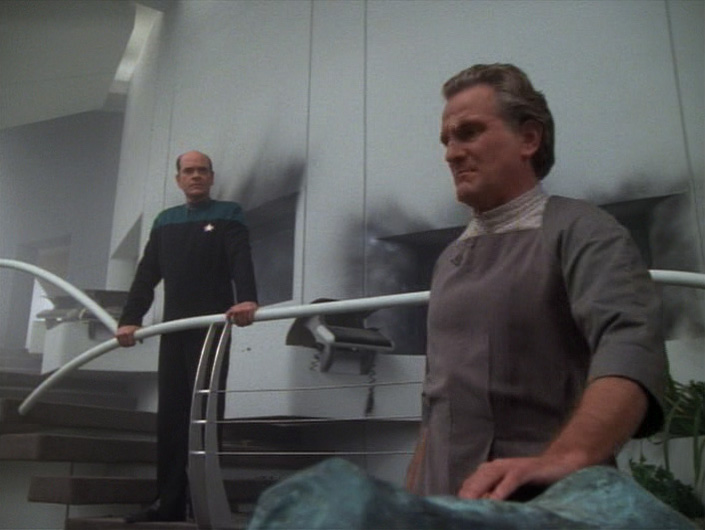
The Doctor and Quarren in “Living Witness”
“Living Witness” ends with a final historical record depicting Quarren and The Doctor working together to write and right history, and the claim their example brought peace to the planet. History is not immutable. Heritage is no excuse for hatred. And hard work is the only cure.
In the era of “alternative facts”, “fake news:”, and HBO’s Confederate set to air amidst ongoing arguments in favor of the Confederacy, alternate universe stories may be considered dangerous or damaging. But at their best, they encourage us to ask interesting and important questions about who we are and what matters to us, and highlight the transformative power of story.
All right – I was literally listening to this song before I saw this online, so you got me there.
I think you really touched the surface of a great Star Trek storytelling device. As you said, there is a lot of power in “Living Witness.” Good stuff.